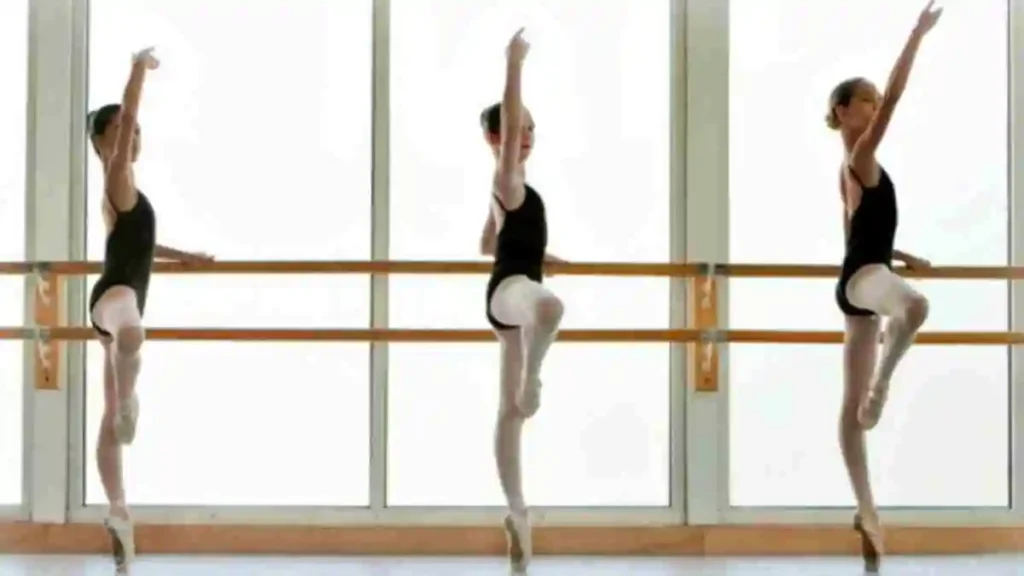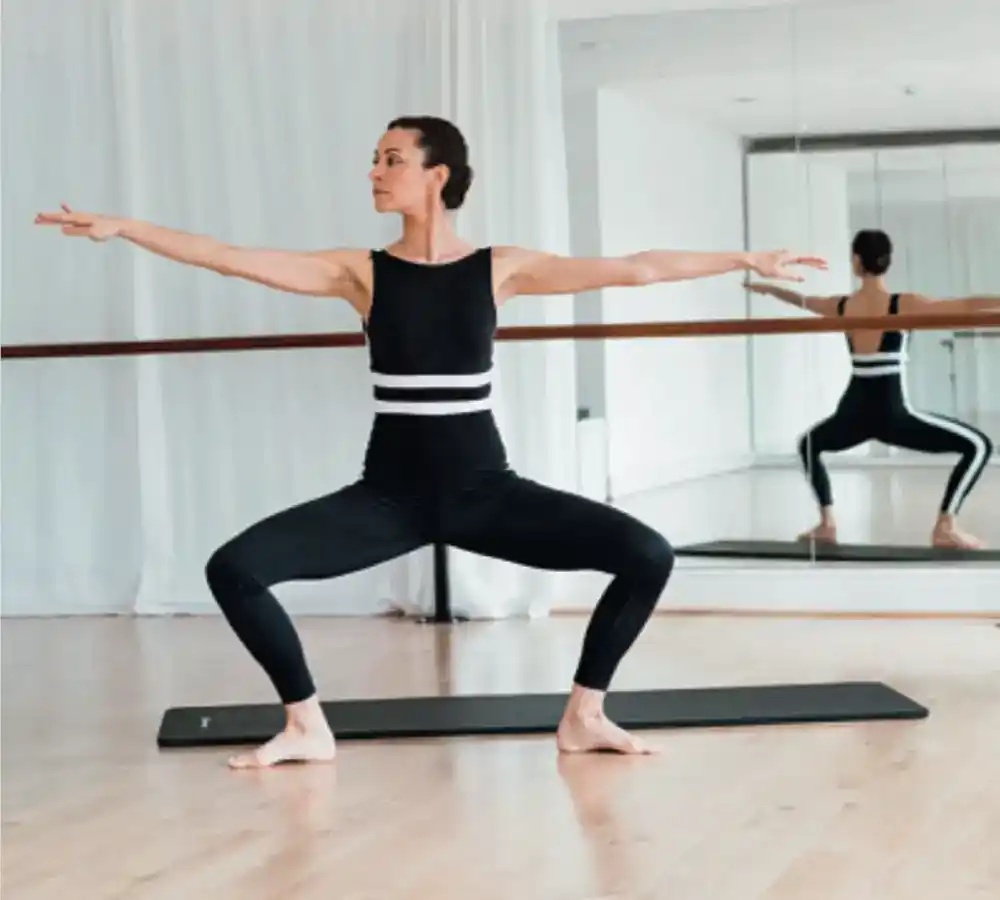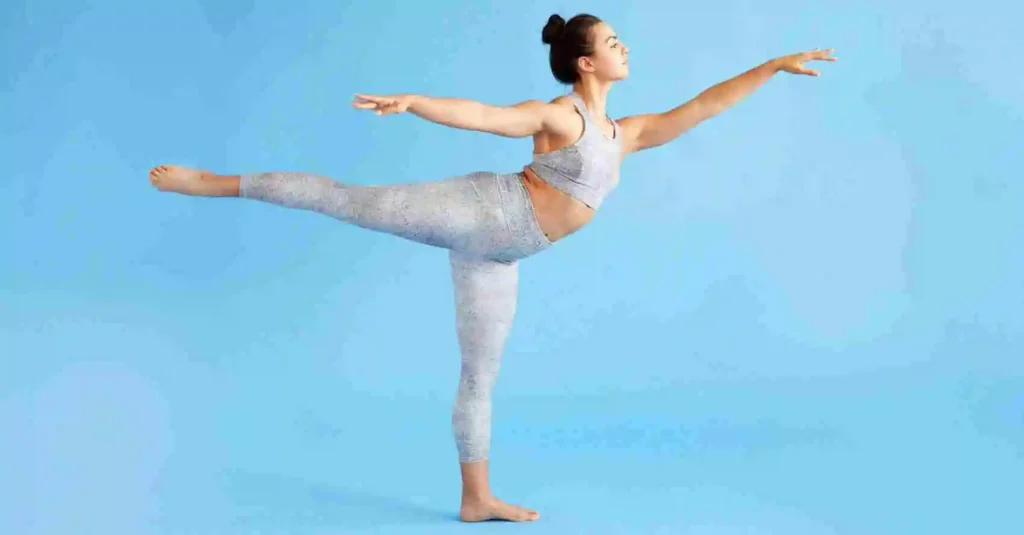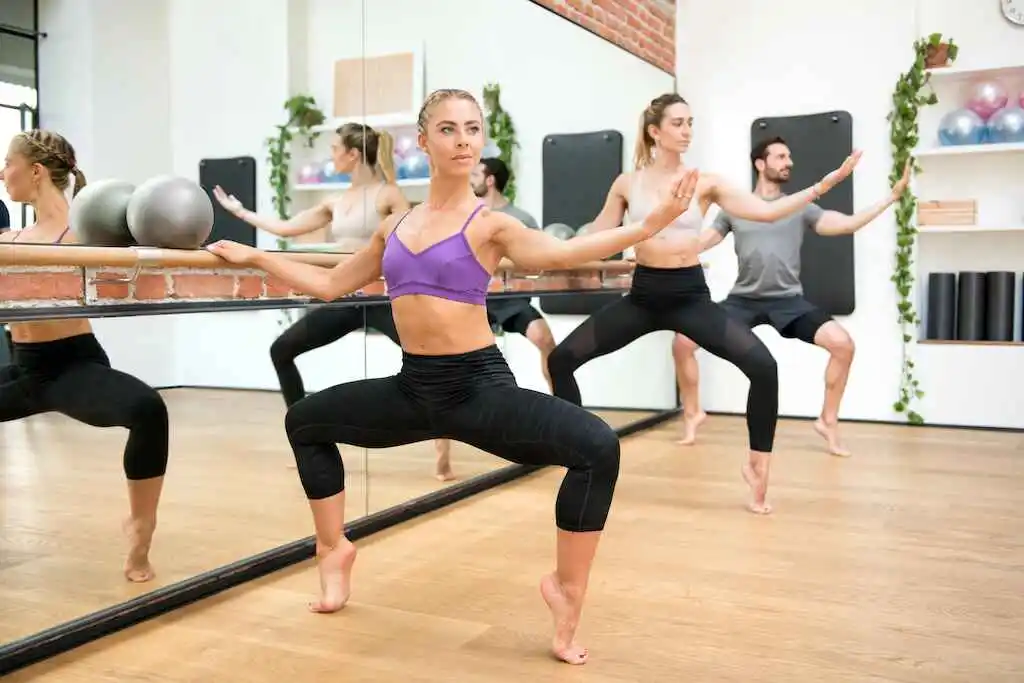Barre Workout
Barre workouts combine elements of ballet, Pilates, yoga, and strength training into a low-impact, full-body exercise.
The method uses a ballet barre (or a sturdy surface like a countertop or chair) for support, incorporating small, controlled movements, isometric holds, and high repetitions. This workout style is accessible to all fitness levels and helps improve posture, flexibility, strength, and endurance.
What is Barre?
A low-impact workout, barre incorporates aspects of Pilates, yoga, and ballet into a single physical fitness regimen. Despite being named after the fixed railing used in ballet, it is not only for dancers. Barre lessons draw participants from a wide range of backgrounds because they emphasize muscular endurance, flexibility, strength training, and the use of the core (abdominal) muscles.
Barre uses highly precise movements and many repetitions to combine elements of ballet with an endurance-based twist.
Similar to yoga, barre sessions come in a variety of forms. Some are faster-paced and focus more on cardiovascular exercises. Others have slower movement transitions and concentrate more on form and technique. Classes usually last between thirty to forty-five minutes, and the routine includes warm-up and cool-down exercises.
In essence, barre emphasizes using your entire range of motion to build your muscles.
When your muscles are in the middle range and not fully extended or flexed, they are at their strongest. Your muscles in the end ranges are a little weaker, and barre helps strengthen those areas.
The advantages of barre
Like any other workout, you’ll probably reap a variety of benefits if you occasionally attend a barre class. However, when you approach barre consistently, it offers the greatest benefits.
Whether it’s more repetition, more weight, or more complex movement, each week should provide a little bit more and build upon the one before it.
When used consistently, barre can offer the following advantages:
Better posture and flexibility
We frequently feel slumped or rounded over when we’re accustomed to spending a lot of time sitting down throughout the day. The goal of barre exercises is to build stronger muscles in your back, shoulders, hips, and chest so that they can support better posture.
In a barre class, you are expected to adopt a dancer’s stance. Your arms are being held in place by your back muscles, which are raised and engaged. Holding your arms in different ballet postures will, when done properly, activate several of your postural muscles.
Toning muscles
A brief, quick series of repetitions is the foundation of almost all barre exercises. You’re not hurrying through it, though. To train, tone, and strengthen even the smallest muscle fibers, every movement is meticulously regulated and concentrated.
Being highly mobile necessitates having high strength. You need to be able to manage your range of motion and control your mobility.
Preventing injury
Barring also has a therapeutic component. Compared to high-intensity interval training (HITT), it is less taxing on your joints since it uses less resistance and weight.
Low-impact exercises do not involve jumping or plyometric exercises like burpees or high knees. Although barre still burns, it doesn’t have the same impact as some other exercises, so I wouldn’t describe it as light. Therefore, it might be a little more accommodating to a wider range of individuals.
Increasing the link between your mind and body
You’ll pay close attention to how you’re strengthening particular muscle groups because of the strong focus required of you. You’re also building your mind-body connection as you experiment with different techniques and work on your form, which will help you focus and attract attention to what you’re doing. Your mental toughness, endurance, and stamina can all get better with time.
It’s typical practice in the dance industry to continuously evaluate one’s body awareness and stance, which comes with mastering various postures and positions. Like in yoga or Pilates, there is a lot of emphasis on breathing and controlling your breath while performing the motions.
Creating a sense of community
Similar to yoga and Pilates, barre sessions provide a group setting where participants work toward shared objectives. It also provides an opportunity to connect with people via friendly, casual competition and physical health. According to studies, taking part in group fitness courses like barre tends to improve one’s physical, mental, and emotional well-being and significantly reduce stress.
Many people enjoy attending classes because of the accountability they provide. Another key benefit is that it’s a terrific method to make friends.
Drawbacks of Barre Exercises:
You might not develop functional strength.
Compound exercises that employ several muscle groups and joints, such as lunges and squats, may not be used in barre sessions. These practical exercises improve your strength for daily tasks like carrying groceries or climbing stairs.
Perhaps the heart isn’t sufficiently challenged.
A barre class’s cardio may not be enough for cardiovascular wellness. Additionally, the post-exercise burn with barre class has a limit. The number of calories expended during and after a workout may be increased more effectively by other types of exercise, such as resistance training and high-intensity interval training.
You might reach a plateau.
Barre class might help your body adjust. You can maximize your strength. To avoid this plateau, we must constantly challenge our bodies.
Do Barre Exercises Work?
You must ask yourself “Effective for what?” to determine whether barre exercises are beneficial. They are undoubtedly beneficial for enhancing muscular endurance, alignment, flexibility, and core strength. Their ability to “lift” and “shape” specific body parts—especially the hip and waist area—is what attracts a lot of clients.
Additionally, you will encounter a variety of barre exercise methods based on the specific focus of the class you are contemplating as well as the skill and dedication of the instructors.
These particulars will affect how engaging and fun you find the courses, which is a critical factor that will affect your motivation to return and continue your exercise regimen—another important factor to take into account when assessing the efficacy of a program and your level of satisfaction.
Bare Exercise and Loss of Weight
Generally speaking, the goal of barre exercises is not to increase cardiovascular fitness. Furthermore, they’re not made to significantly increase muscle mass. The two aspects of fitness that have the greatest impact on weight loss and body composition alterations are cardiovascular endurance and muscular strength.
Therefore, barre courses might not be the quickest or most efficient approach to see results if you want to see noticeable improvements in your body composition. Naturally, that does not imply that certain outcomes are not achievable. Including a barre workout in your regimen might help you tone your muscles and correct your posture if you’re already quite fit.
On the other hand, if you’re a sedentary person and you choose to start going to barre classes, you’ll probably notice changes in your tone and weight because of the relative increase in exercise and strength training.
Does Barre Help People Lose Weight?
Weight loss can be facilitated by any type of exercise, and barre is no different. According to the ISSA, faster-paced lessons can also have a cardiac benefit, even though barre focuses on strength and flexibility. Increasing your heart rate can aid in weight loss by burning more calories.
It’s difficult to quantify how many calories barre classes burn because of their varying intensities and the lack of research on the possible weight loss effects of barre.
Remember that the same warning applies to all forms of exercise: If you don’t combine it with other healthy behaviors and pay attention to what you eat, you won’t lose weight.
Barre Equipment
Even while barre exercises don’t require any equipment at all, you’ll frequently employ a few supports to increase your strength. One essential is a small set of weights, or soup cans if you don’t have any, which you’ll use to increase the difficulty of presses and curls.
When performing ab exercises that require lifting, lowering, or holding your legs, you can additionally position a yoga block (or a book) between your knees to activate your core, she suggests. Barre leg workouts can also include 9-inch Pilates balls, looped resistance bands, and, of course, a ballet barre. Consider purchasing a workout mirror, which is occasionally available as a Cyber Monday fitness promotion, for at-home barre sessions (as well as other classes).
How to Begin With Bare Exercises
To ensure that your barre experience is successful, heed these tips:
Attend a course for beginners: A beginner barre class that is slow and goes over proper positions and body alignment would be beneficial if you’re new to fitness and dance. Because you can work with a teacher one-on-one, an in-person introductory barre session is the ideal option.
Pay attention to form: Because performing many repetitions in the incorrect position might raise the risk of injury, form is crucial in barre. To monitor your form, in-person courses usually take place in front of mirrors. Try to place yourself in front of a mirror when practicing barre at home so that you can as closely replicate the instructor’s movements as you can. Some important things to keep in mind: Maintain an engaged core, shoulders pulled back and down, and knees in alignment.
Take it easy: After barre lessons, especially if you’re new, it’s normal to feel sore in your muscles. You should be too exhausted to do barre every day if you’re making the most of your lesson. Therefore, during the first few weeks of barre, start slowly by taking no more than two courses each week on nonconsecutive days. Increase the number of classes gradually, but always allow yourself at least one day off.
Just use your body weight: Equipment such as light hand weights and small-weight exercise balls are frequently used in barre classes. When mastering the positions, it’s best to use your body weight. Your muscles will be strained by barre postures, particularly if you’re not accustomed to performing so many repetitions. Your exercise form may deteriorate as your muscles grow weary.
How to Increase the Benefits of a Bare Workout
You could be prepared to increase the intensity of your barre workouts after you’ve completed a few of them.
Few methods are:
Perform additional repetitions: Every movement in barre classes already involves a significant number of repetitions. However, if you’re doing a barre workout at home, you can always sneak in a few more.
Increase the resistance: If you’re new to barre, it’s better to stick around body weight. Feel free to use lighter weights once you are at ease in the poses. However, if you’re performing 20 to 30 repetitions, you shouldn’t use anything heavier than three pounds. When you have a lot of positions to perform and a high repetition count, even the smallest weights might catch you off guard.
Reduce your speed: Pulses are a common feature of barre exercises, which means that you move some body parts very little but at a comparatively fast pace. Decreasing your pulses will intensify the burn and lengthen the time your muscles are tense.
Barre Nutrition Advice
For a barre session, it’s critical to properly fuel your body. Fatigue can be avoided by drinking plenty of water and eating a healthy diet overall. Make the most of your barre training by using these dietary suggestions.
Before
Eat a small, high-carb snack 30 to 60 minutes before class if you haven’t eaten in a few hours to maintain your energy levels. In addition to drinking lots of water, try a banana, bagel, dried fruit, applesauce, or fruit smoothie. Steer clear of spicy, high-fat, or high-fiber foods and fizzy drinks since they might cause bloating, gassiness, and sluggishness.
When working out for less than an hour, water is all you need. It may be necessary to consume extra carbohydrates and electrolytes (minerals lost via perspiration) in the form of a sports drink or gel for barre courses that last longer than 60 minutes or that are combined with a long-duration activity: walking.
After
Start your post-workout recovery with a snack that has 100–300 calories, 20–30 grams of protein (to build and repair muscle), and about 15 grams of carbohydrates (to restore muscle glycogen, a kind of fuel for exercise) if you won’t be eating for a few hours. Continue drinking water to stay hydrated.
Barre Workouts
Turnouts

Groups of muscles: rotator flexors, deep hips, and glutes
- For other movements like relevé or plié, this stance serves as a starting point and variation.
- Start standing with your heels together.
- Maintaining your knees in alignment with your toes, open your toes out to a 45-degree angle while shifting your weight back into your heels.
Changes: Everybody will have a different turnout. Work in a range that doesn’t cause pain and lets you keep your posture; never push your turnout.
Pliés

Muscle groups: Quads and gluteals
- Place your feet flat on the floor, toes pointing forward, and heels together.
- Without allowing your heels to rise off the floor, bend your knees.
- Maintain a straight spine by placing your knees over your toes and your shoulders over your hips.
- To stand again, straighten your legs.
- For three sets of eight reps, repeat.
Changes: Place your other hand on your hip and use the other hand to grab onto a chair, countertop, or barre if you need more support.
A higher level of difficulty can be achieved by increasing the number of repetitions, extending your holds, or adding hand weights.
First position relevés
Muscle group: Calves
Place one hand out in front of you, palm facing you, and hold a chair, countertop, or barre with the other as you stand up on one or two feet. (like you’re about to hug someone).
Point your toes slightly out and bring your heels together.
Engage your core and calves to raise onto the ball of your feet.
Keep your back and knees straight and only raise your feet as high as you can.
Repeat for three sets of eight reps.
Changes: Waters advises, “Try doing this with parallel feet before moving into a turned-out position.” “There are advantages to doing both.”
Enhanced difficulty: To put more strain on your calf, start on two feet and work your way up to one foot.
Tendu
Stretching out one leg till only your toes touch the floor.
Arabesque

Standing on one leg while extending the other leg behind you is known as Arabesque.
Raise the barre
Barre may be both enjoyable and difficult. The more you try, the more favorable outcomes you might anticipate. Whatever class you enroll in, remember to be kind and patient with yourself and consider how you will learn the steps and the skills in the future. For the teacher to accommodate you as a novice, make sure you also introduce yourself at the beginning of class.
It is a humble feeling to be barred. Don’t guess what you should be doing; instead, be willing to ask questions. This is the point at which injuries occur.
FAQs
A barre workout: what is it?
Barre is a type of exercise that is typically done in gyms or specialized studios in group groups. Its use of the ballet barre and its integration of ballet-inspired motions set it apart from other group exercise activities.
Does barre help people lose weight?
Anyone looking to lose a few pounds may find barre to be a useful workout option due to its intensity. For a 155-pound person, each barre class can burn between 300 and 400 calories.
Is barre challenging for newcomers?
Because each exercise can be altered to suit (and challenge) students of any ability level, the Bar Method is an excellent barre workout for novices. A consistent barre regimen eventually optimizes your workout outcomes, from a stronger back to toned arms and a thinner body.
What drawbacks does barre have?
You might not develop functional strength.
Compound exercises that employ several muscle groups and joints, such as lunges and squats, may not be used in barre sessions. These practical exercises improve your strength for daily tasks like carrying groceries or climbing stairs.
Is thirty minutes of barre sufficient?
Indeed! particularly the Xtend Barre 30-minute classes. You can choose to exercise and work out every day with these classes, and then continue with your day.
How soon will Barre start to show results?
Although some students claim to notice a change in their physique after just a few courses, don’t be shocked if it takes a few weeks to see the results of your labors when you look in the mirror.
Which is better, Pilates or Barre?
While Pilates targets the entire body at once, especially your core muscles in each action, Barre tends to isolate specific body areas with short, repetitive motions and pulses. Pilates will improve your mobility and stability, but a barre session will probably make you sweat and burn more.
Reference
- Kttp, T. H. P. D. O. (2020, January 9). Barre Workouts: Learn the benefits and limitations – Athletico. Athletico. https://www.athletico.com/2017/11/20/barre-workouts-learn-the-benefits-and-limitations/#:~:text=You%20may%20not%20gain%20functional,stair%20climbing%20or%20carrying%20groceries.
- Clinic, C. (2025, January 7). Behind Barre: What it is and how to make it work for you. Cleveland Clinic. https://health.clevelandclinic.org/what-is-barre
- Falk, M. (2022, July 29). Your comprehensive guide to barre. Shape. https://www.shape.com/fitness/workouts/types/low-impact/what-is-barre
- Ascm-Cep, L. W. M. (2020, July 20). Are barre workouts effective? Verywell Fit. https://www.verywellfit.com/barre-workouts-whats-the-hype-85957
- Asp, K. (2024, October 25). Barre workouts: health benefits, how to get started, and how to get better. EverydayHealth.com. https://www.everydayhealth.com/fitness/barre-workouts/guide/



2 Comments